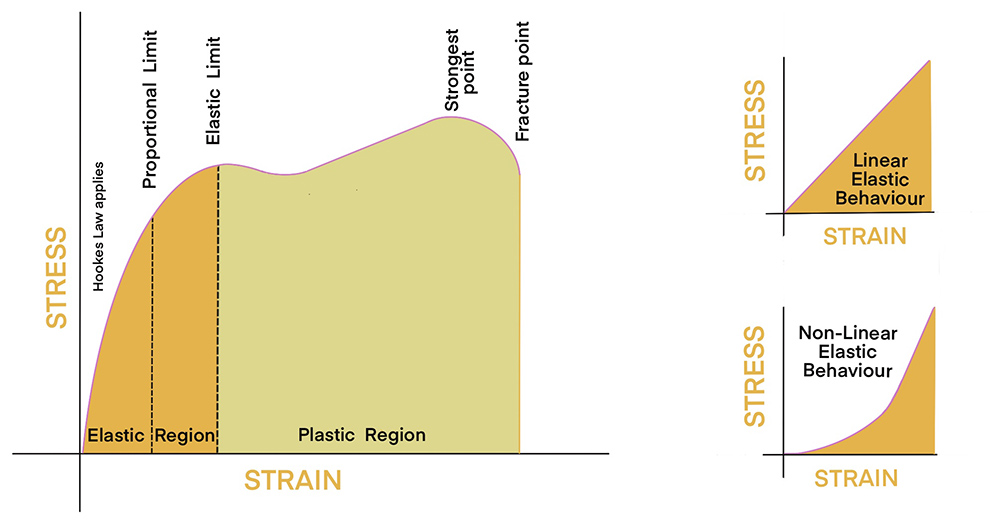Elastic limit
Contents |
[edit] Introduction
All materials show elastic behaviour to a degree, some more than others. If, after a load has been applied and then quickly removed, a material returns rapidly to its original shape, it is said to be behaving elastically. Elasticity is a crucial characteristic of building materials; if it were not, buildings would suffer continuous deformation under load and ultimately would collapse.
[edit] Elastic limit
A solid material’s elastic limit is the maximum stress per unit area it can withstand before there is permanent deformation. In other words, it is the limit of the material’s elasticity, for up to that point, the solid can resume its original shape when the load is removed; after that point, it undergoes permanent (plastic) deformation and will not return to its original shape even after the load (yield load) has been removed.
On a graph showing a stress-strain curve, the point of the limit of elastic behaviour is called the ‘yield point’ and this is where plastic deformation begins – some of this deformation will be plastic and irreversible. In structural engineering, the yield point is regarded as a ‘soft failure’ mode which does not usually cause catastrophic or ultimate failure. It might be referred to as the fracture point or in the case of structural failure the breaking point, such as where a timber beam goes beyond, the yield, soft failure and fracture to break and collapse.
No structural material exhibits perfect elasticity: depending on the type of structure and the material, permanent deformations are unavoidable whenever loads exceed certain values. That is why engineers design structures to ensure the materials are being used within their elastic range and the loads involved will not produce permanent deformations.
All structural materials behave plastically beyond their elastic range. However, even if some materials show elastic behaviour, they may – after a long period of service, usually many years – exhibit a degree of plastic flow (or creep).
[edit] Linear elasticity
This occurs when the deformation in a material is proportional to the load applied. So, if a person weighing 50kg causes a diving board to deflect by 300mm, and another person weighing 100kg causes an identical board to deflect by 600mm, the diving board is exhibiting linear deflection. Most structural materials are, within limits, linearly elastic and are used within their linearly elastic range.
[edit] Related articles on Designing Buildings
- Concept structural design.
- Detailed design.
- Elements of structure in buildings.
- Moment.
- Stiffness.
- Structural engineer.
- Structural principles.
- Structural systems for offices.
- Structural vibration.
- Structures at the end of their design life.
- The development of structural membranes.
- Types of structural load.
- Vibrations.
Featured articles and news
RTPI leader to become new CIOB Chief Executive Officer
Dr Victoria Hills MRTPI, FICE to take over after Caroline Gumble’s departure.
Social and affordable housing, a long term plan for delivery
The “Delivering a Decade of Renewal for Social and Affordable Housing” strategy sets out future path.
A change to adoptive architecture
Effects of global weather warming on architectural detailing, material choice and human interaction.
The proposed publicly owned and backed subsidiary of Homes England, to facilitate new homes.
How big is the problem and what can we do to mitigate the effects?
Overheating guidance and tools for building designers
A number of cool guides to help with the heat.
The UK's Modern Industrial Strategy: A 10 year plan
Previous consultation criticism, current key elements and general support with some persisting reservations.
Building Safety Regulator reforms
New roles, new staff and a new fast track service pave the way for a single construction regulator.
Architectural Technologist CPDs and Communications
CIAT CPD… and how you can do it!
Cooling centres and cool spaces
Managing extreme heat in cities by directing the public to places for heat stress relief and water sources.
Winter gardens: A brief history and warm variations
Extending the season with glass in different forms and terms.
Restoring Great Yarmouth's Winter Gardens
Transforming one of the least sustainable constructions imaginable.
Construction Skills Mission Board launch sector drive
Newly formed government and industry collaboration set strategy for recruiting an additional 100,000 construction workers a year.
New Architects Code comes into effect in September 2025
ARB Architects Code of Conduct and Practice available with ongoing consultation regarding guidance.
Welsh Skills Body (Medr) launches ambitious plan
The new skills body brings together funding and regulation of tertiary education and research for the devolved nation.
Paul Gandy FCIOB announced as next CIOB President
Former Tilbury Douglas CEO takes helm.
UK Infrastructure: A 10 Year Strategy. In brief with reactions
With the National Infrastructure and Service Transformation Authority (NISTA).























